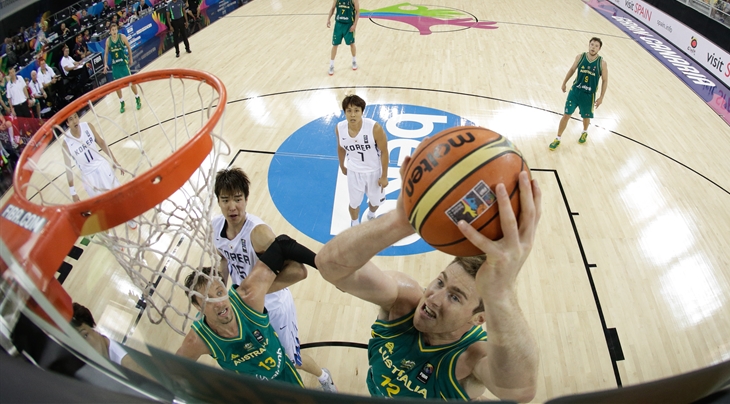
Another peak into the future
CHANGSHA (Paulo Kennedy's View from Downunder) - Last week's column about Oceania's move to Asia drew a lot of interest, so I've decided to look into the nuts and bolts of how it will all work.
For those who haven't caught up with the news, starting in 2017, qualification for the FIBA Basketball World Cup will be done through a series of home and away games in 'windows' throughout a 15-month period.
So, starting in November 2017 the Boomers and Tall Blacks will head overseas to places like Jordan, China, Korea, India, the Philippines and more for meaningful qualification games, and then welcome those opponents Downunder for return legs.
It's a system with many similarities to that used by FIFA, but the integration of the Olympic Games into the senior men's basketball calendar makes it even better in my opinion. Here's a rundown of how it works.
In the Asian zone - which I think should be called Asia-Pacific, but anyway - countries will be divided into 16-team pools named Division A and Division B.
The teams in Division A will be playing off for seven places at the 2019 FIBA Basketball World Cup in China.
The short story is this: Division A will be split into four groups of four, and after the first round of qualifying - involving three home games and three away matches - the bottom team from each group will drop out, and the remaining 12 teams will be split into two groups of six.
In the second stage teams will again play three games at home and on the road, with the top three teams from each group, and the fourth-placed team with the best record, progressing to China 2019.
The long story is this: As a fictitious example, let's say the Boomers are in Group A with Chinese Taipei, Kuwait and the Philippines. We'll say New Zealand are in Group B with Iran, India and Singapore.
They will play all three group opponents both home and away during two-game, 10-day windows in November 2017, February 2018 and June/July 2018 for a total of six games.
Let's pretend both groups go according to world rankings, meaning Kuwait and Singapore finish last in their respective pools and drop out.
Groups A and B then combine (as do the top three from Groups C and D), with wins or losses against other teams that have progressed carried over into the second round - in Australia's case that would be the four games against Chinese Taipei and the Philippines.
The Boomers would then play New Zealand, Iran and India at home and away in the second stage during qualifying windows in September 2018, November 2018 and February 2019.
After that has finished, and all teams have played 12 games in total, the top three teams from both sides of the draw will qualify for China 2019.
The countries who have finished fourth will then be compared, with the best record also being given passage through to the World Cup.
This is one small area where I disagree with the new system. The ideal scenario is for the two fourth-placed teams to play off for the last remaining spot.
This has been decided against because of logistics, however, if we can run qualifying tournaments just two months before the Olympics, I don't see why we can't run a simple home and away playoff in the June/July window of 2019, which is currently vacant.
Something to think about, anyway.
So that's qualification, now for the real stuff, and another big change is the FIBA Basketball World Cup becoming the major pathway to the Olympic Games from 2019 onwards.
A total of 32 teams will be arranged into eight groups of four at the World Cup. The top two from each group will progress to the top 16, where they will play off in four groups of four. Then the top two from each of those pools will progress to the knockout quarter-finals and beyond.
The highest placed teams from Oceania, Asia and Africa at the 2019 World Cup will qualify directly for the Tokyo Olympics, along with the top two performing teams from Europe and the Americas.
So let's say Australia finishes fourth and New Zealand fifth at the World Cup, the Boomers will get the spot. If the Tall Blacks finish 16th and the Aussies 17th, it will be the Kiwis off to Tokyo, so classification games could have a lot of meaning.
Assuming Japan is given automatic qualification as the host nation, that will leave just four spots available for 2020, which will be decided by four, six-team FIBA Olympic Qualifying Tournaments (OQTs).
Places in those qualifying will again be determined by performance at China 2019 or the World Cup qualifiers prior to that, with a minimum of two teams from Asia (Pacific), Africa, Europe and the Americas taking part.
OK, take a deep breath. It's a lot to take in, but it's a simple system once you get your head around it.
Play well enough in the home and away qualifiers, then you get to the World Cup. Be a standout from your continent at the World Cup, then you play at the Olympics. Simple.
It's a huge step forward, and it will mean more hardened Australian and New Zealand teams will head to the World Cup and Olympics than is currently the case.
The two Oceania nations will certainly be favourites to progress from Asian qualifying, but road games in places like Kazakhstan, Iran, China, Korea and the Philippines will provide stern tests.
All that's left to say is bring on November 2017!
Paulo Kennedy
FIBA
FIBA's columnists write on a wide range of topics relating to basketball that are of interest to them. The opinions they express are their own and in no way reflect those of FIBA.
FIBA takes no responsibility and gives no guarantees, warranties or representations, implied or otherwise, for the content or accuracy of the content and opinion expressed in the above article.

















